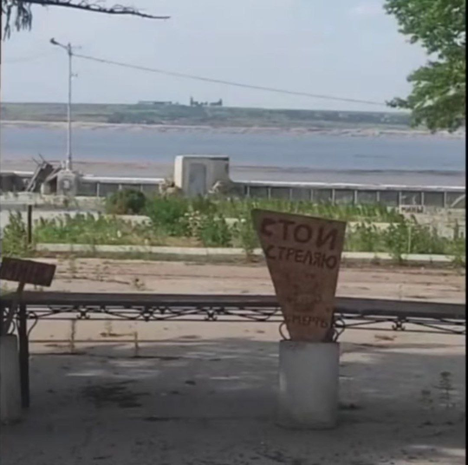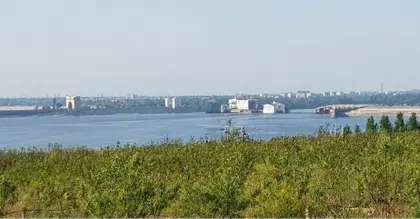The Russian army’s demolition of a major hydroelectric dam on the Dnipro River appears to have backfired by turning one of Europe’s most massive waterways into an obstacle Armed Forces of Ukraine (AFU) ground forces could, most likely, cross a good deal more easily.
Prior to the Kremlin’s June 6 destruction of the Kakhovka hydroelectric station in southern Ukraine, the 240-km-long reservoir formed by the Dnipro upstream was between 5-20 km wide with an average water depth of eight meters, and effectively impassible to ground troops absent a major amphibious operation.
According to most analysts, the Kremlin ordered the dam’s destruction in order to make the entire length of the Dnipro River dividing Russian and Ukrainian forces unfordable for the long term, narrowing the area where Kyiv’s forces might attack.
The flood wave killed dozens and, for the short term, placed a world-class military obstacle dividing the Russian military and the Armed Forces of Ukraine (AFU) across the entire southern front. But two weeks later, a good deal of the water obstacle the Russians had planned to create is shallow and drying out, and in some places, it’s simply disappeared, open-source media showed.
June 20 Maxar satellite images the Kakhovka reservoir in its past major lake form is gone, having turned into an open flood plain dotted with shallow pools, and bisected by the Dnipro in its natural state: a stream 500-1000 meters wide with dry banks along about half its length.

South Korea Demands 'Immediate Withdrawal' of North Korean Troops in Russia
Recent satellite images of the Kakhov reservoir.#Ukraine #News #Kakhovka pic.twitter.com/GkTJWr1zyV
— Sasha White (@rusashanews) June 21, 2023
The river flood plain upstream and downstream is, local media said, drying rapidly in warm weather, and reinventing itself as multi-kilometer-wide belt of open dirt, mud and sand. In some places, where getting from one side of the Dnipro to the other was only possible by boat, now appears to be fairly easy going for a conventional 4WD civilian car, some local images suggested.
The #Kakhov reservoir before and after the #Russian attack. pic.twitter.com/thrLKvcSuQ
— NEXTA (@nexta_tv) June 10, 2023
There is no water left in the Kakhov reservoir near the #Zaporizhzhia nuclear power station in occupied #Enerhodar
— Tim White (@TWMCLtd) June 20, 2023
There is still no imminent threat to the safety of the plant due to its own small reservoirs and reduced operations at the site. However it could be a problem later pic.twitter.com/ezJ767yG1Q
Maksym Ostapenko, a hydrology scientist, in June 20 comments to the UNIAN news agency said that water around Khortytsia, an island well upstream near the Dnipro River city Zaporizhzhia, receded by about 30-40 m. Near the Dnipro tributary river Konka, a militarily-critical waterway cutting through the frontline Mala Tokmachka and Orikhiv sectors, what used to be a perennial river is now a mixed territory of islands, lakes, rivers, he said.
At some Dnipro locations, particularly where the river narrows, driving from bank to bank is still impossible. In the vicinity of the dam itself, according to images published by the Radio Liberty program Skhemi on June 16, water was lapping near the roadway atop the dam, and the adjacent Nibulon boat terminal, near the village Kozatske was fully under water.
Three days later water flow at those locations had, according to social media images, visibly fallen but river bottom was still fully inundated. A military unit attempting to cross the Dnipro at that location would almost certainly have to swim its vehicles across close to a kilometer of open water, Kyiv Post research found.
According to Ukraine’s Army General Staff, the Russian high command since the outset of Kyiv’s summer offensive has transferred troops from the already thinly-held Dnipro River line mostly in the Kherson region, to buttress defenses in the Zaporizhzhia and Donbas sectors against ongoing Ukrainian assaults.
Kremlin gadfly Igor “Strelkov” Girkin, a Russian nationalist blogger and regional commander during Moscow’s 2014 first invasion of Ukraine, said that the Ukrainian military could taking advantage of reduced flow in the Dnipro River, and thinning Russian defenses behind it, and cross by assault. There is historical precedent and the Russian army in 1920 and the Red Army in 1943 attacked across the Dnipro successfully.
“Taking into account how much bridging equipment (the West) has transferred Ukraine, this (crossing the Dnipro River by assault) is not such an obstacle. You have to get down to business and make a plan, and prepare everything fully, (to do it),” he said.
Ukrainian military spokespersons have not commented on the military implications of Russia’s unplanned draining of the biggest water barrier between the AFU and the Russian military, beyond stating that the Kyiv high command “prepared” for the Kakhovka dam’s destruction.

You can also highlight the text and press Ctrl + Enter









